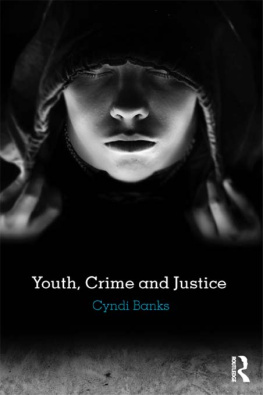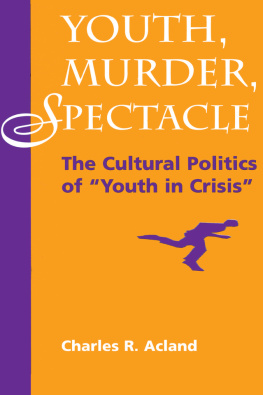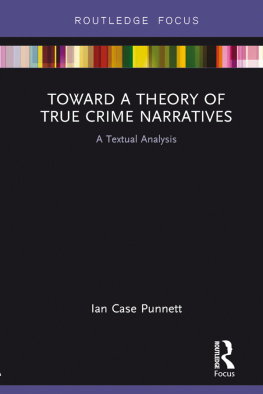Changing Narratives of Youth Crime
In recent years, western societies have experienced a fundamental transformation in the way crime is understood and dealt with. Against the backdrop of a current great interest in narratives in criminology, this book draws on a narrative perspective to explore this transformation.
Drawing on data from Germany, the book focuses on changing narratives of youth crime in recent decades and the exact narratives that have been used, abandoned, invented or criticized in order to instil particular understandings of crime and measures to act against it. The author draws upon a wide range of sources, including debates on youth crime in six parliaments from 1970 to 2012; articles on youth crime in four police and six social work journals from 1970 to 2009; and case studies with 15 young defendants who were interviewed before and after their trial and whose trial was observed. In doing so, the author reconstructs narratives over several decades and, overall, reveals a fascinating and multifaceted scope of narratives of youth crime.
This book will be of great interest to students and scholars of youth crime and justice, as well as criminology, sociology, politics and social work more broadly.
Bernd Dollinger is a professor of pedagogy and social work at the University of Siegen, Germany. Youth crime is his long-standing focus of research. Bernds special research interests relate to drug use, criminal policy, professionalism in dealing with juvenile delinquency and processes of identity negotiation of youths. He has published extensively on juvenile delinquency. His publications include handbooks, textbooks and numerous research papers. Most recently, he has been particularly interested in reconstructing measures against crime from below, as it were, from the often neglected perspective of the defendants and convicts. They in particular have a lot to tell, and their stories are individually linked to cultural crime discourses.
Routledge Studies in Crime and Society
Digital Piracy
A Global, Multidisciplinary Account
Edited by Steven Caldwell Brown and Thomas J. Holt
Offender and Victim Networks in Human Trafficking
Ella Cockbain
Mothering and Desistance in Re-Entry
Venezia Michalsen
Cyber-risk and Youth
Digital Citizenship, Privacy and Surveillance
Michael Adorjan and Rosemary Ricciardelli
Gun Studies
Interdisciplinary Approaches to Politics, Policy, and Practice
Edited by Jennifer Carlson, Harel Shapira and Kristin A. Goss
The Myth of the Crime Decline
Exploring Change and Continuity in Crime and Harm
Justin Kotz
Execution by Family
A Theory of Honor Violence
Mark Cooney
Changing Narratives of Youth Crime
From Social Causes to Threats to the Social
Bernd Dollinger
For more information about this series, please visit: www.routledge.com/Routledge-Studies-in-Crime-and-Society/book-series/RSCS
Changing Narratives of Youth Crime
From Social Causes to Threats to the Social
Bernd Dollinger
First published 2020
by Routledge
2 Park Square, Milton Park, Abingdon, Oxon OX14 4RN
and by Routledge
52 Vanderbilt Avenue, New York, NY 10017
Routledge is an imprint of the Taylor & Francis Group, an informa business
2020 Bernd Dollinger
The right of Bernd Dollinger to be identified as author of this work has been asserted by him in accordance with sections 77 and 78 of the Copyright, Designs and Patents Act 1988.
All rights reserved. No part of this book may be reprinted or reproduced or utilised in any form or by any electronic, mechanical, or other means, now known or hereafter invented, including photocopying and recording, or in any information storage or retrieval system, without permission in writing from the publishers.
Trademark notice: Product or corporate names may be trademarks or registered trademarks, and are used only for identification and explanation without intent to infringe.
British Library Cataloguing-in-Publication Data
A catalogue record for this book is available from the British Library
Library of Congress Cataloging-in-Publication Data
A catalog record for this book has been requested
ISBN: 978-0-367-07469-2 (hbk)
ISBN: 978-0-429-02095-7 (ebk)
Typeset in Bembo
by Apex CoVantage, LLC
Contents
Prefaces can serve to prepare the reader. They do so successfully if they briefly outline what perspective the reader can expect. I try to do this here by starting with a quote from the Polish doctor and researcher Ludwik Fleck, who aptly describes my starting point. In his analyses, Fleck found that epistemologists each tended to observe something specific as a clear given on which they then based their theories. For some, thought, and for others, an empirical fact was fixed, in other words unchangeable. Fleck then asked:
Would it not be possible to manage entirely without something fixed? Both thinking and facts are changeable.
(Fleck 1935/1981, 50)1,2
Even after decades of poststructuralist and postmodern debate (e.g. Arrigo 2003; Arrigo et al. 2005; Cunneen 2011), this critical comment is in my view still important today, particularly for criminology. One could write the history of criminology as a search for something fixed, for a fixed constant; as the desperate pursuit of something solid and unshakable that ultimately, however, can be found neither in thinking nor in facts. This was my starting point for this monograph.
Let us start with thinking: criminological analysis is heterogeneous. Criminology has boomed in the recent past, particularly in the English-speaking world (Liebling et al. 2017). That boom has revealed its diversity all the more clearly; it is a growing interdisciplinary research field in which there is little unity or consensus. Bosworth and Hoyle (2011, 3) see a risk of criminology increasingly splitting into disparate cliques, where criminologists read the work of others who think like them, write for those very same people and publish only in the journals that they and their colleagues are already reading. If we look at the individual trends in criminology evidence-based criminology, cultural criminology, developmental criminology, narrative criminology, comparative criminology, etc. it is immediately apparent that criminology already only exists in the plural. Criminology is, according to Agnew (2011, 2), a divided discipline. Individual criminological trends ask their own, characteristic questions and use different methods to answer those questions. The fact that contemporary criminology is varied and comprises different, distinct elements represents its interdisciplinary normality. Although criminology has enduring core ideas, arguments and assumptions (Watts et al. 2008, 227), these differ considerably between individual branches and trends. There is no discernible common fixed constant.
In criminology, even facts are no guarantee of such a constant. The central subject, crime, itself varies widely. What is considered crime at different times and in different countries is variable. Reiner (2016, 15) talks of a huge cultural variation across space and time in what has been counted by the law as criminal. There are elements of continuity: for example, homicide, theft and incest were and are often perceived and treated as deviant (Peters 2017). However, this is no guarantee that such elements have had the same significance across different times and countries. According to mile Durkheim (1893/1964, 81), the definition of crime depends on the moral sensitivity of a society. From a perspective not dissimilar to labelling theory, he argued that






